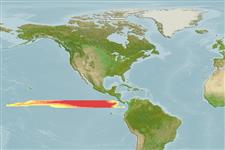>
Myctophiformes (Lanternfishes) >
Myctophidae (Lanternfishes) > Diaphinae
Etymology: Diaphus: Greek, dis, dia = through + Greek, physa, phyo = to beget, to have as offspring (Ref. 45335); similis: From its similarity to D. trachops and to a lesser degree, to D. suborbitalis (Ref. 7454).
Environment: milieu / climate zone / depth range / distribution range
Ekologi
marina batypelagisk; djupintervall 0 - 631 m (Ref. 7454). Deep-water; 10°N - 4°N
Utbredning
Länder | FAO områden | Ekosystem | Förekomster | Point map | Utplanteringar | Faunafri
Eastern Central Pacific.
Size / Vikt / Age
Maturity: Lm ? range ? - ? cm
Max length : 7.2 cm SL (female)
Short description
Bestämningsnycklar | Morfologi | Morfometri
Mjukstrålar i ryggfenan (totalt) : 14; Mjukstrålar i analfenan: 15 - 16; Ryggkotor: 34 - 36. Small patches (scales) of luminous tissue at certain photophores (although subject to erosion, these luminous scales are quite persistent and are evident on specimens that have lost all body scales and most scale pockets).
Life cycle and mating behavior
Maturities | Reproduktion | Spawnings | Egg(s) | Fecundities | Larver
Paxton, J.R., R.J. Lavenberg and C. Sommer, 1995. Myctophidae. Linternillas. p. 1315-1321. In W. Fischer, F. Krupp, W. Schneider, C. Sommer, K.E. Carpenter and V. Niem (eds.) Guia FAO para Identification de Especies para lo Fines de la Pesca. Pacifico Centro-Oriental. 3 Vols. FAO, Rome. (Ref. 9325)
IUCN Red List Status (Ref. 130435)
Threat to humans
Harmless
Human uses
Verktyg
Special reports
Download XML
Internet-källor
Estimates based on models
Phylogenetic diversity index (Ref.
82804): PD
50 = 0.5000 [Uniqueness, from 0.5 = low to 2.0 = high].
Bayesian length-weight: a=0.00759 (0.00332 - 0.01733), b=3.02 (2.83 - 3.21), in cm total length, based on LWR estimates for this Genus-body shape (Ref.
93245).
Trofisk nivå (Ref.
69278): 3.1 ±0.3 se; based on size and trophs of closest relatives
Resiliens (Ref.
120179): Hög, lägsta populationsfördubblingstid mindre än 15 månader (Preliminary K or Fecundity.).
Fishing Vulnerability (Ref.
59153): Low vulnerability (10 of 100).
